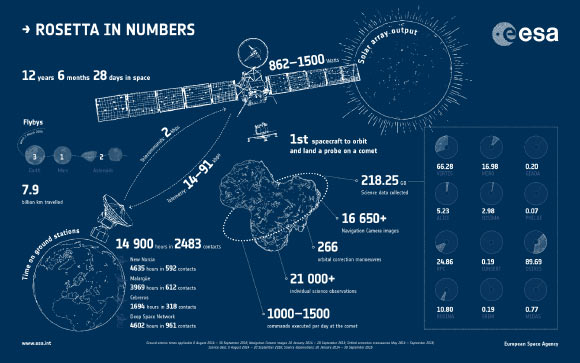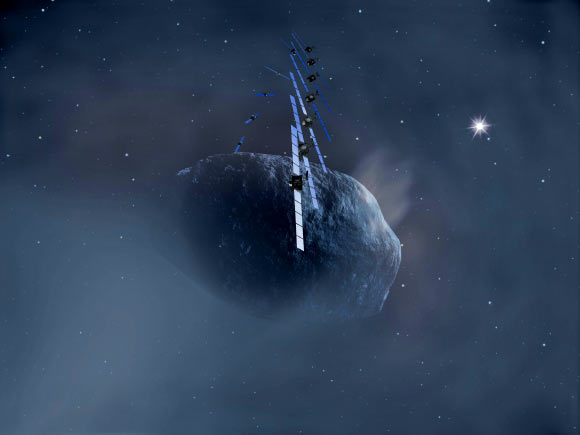ESA’s Rosetta spacecraft is set to complete its mission in a controlled descent to the surface of Comet 67P/Churyumov–Gerasimenko on September 30, 2016, with the end of mission confirmation predicted to be within 20 min of 7:20 a.m. EDT (4:20 a.m. PDT, 11:20 a.m. GMT, 1:20 p.m. CET).
Live streaming will begin at 6:30 a.m. EDT (3:30 a.m. PDT, 10:30 a.m. GMT, 12:30 p.m. CET) via Rosetta.esa.int and Livestream.com.
NASA TV will begin providing live coverage, commentary, interviews and analysis at 6:15 a.m. EDT (3:15 a.m. PDT, 10:15 a.m. GMT, 12:15 p.m. CET). The landing coverage will also be streamed live at Ustream.tv.
Rosetta launched on March 2, 2004 by an Ariane-5 G+ from Europe’s spaceport in Kourou, French Guiana.
To place it on the required orbit to rendezvous with Comet 67P/ Churyumov-Gerasimenko, the spacecraft received four gravity assist maneuvers: three from Earth (March 4, 2005; November 13, 2007; and November 13, 2009) and one from Mars (February 25, 2007).
Rosetta also passed by and imaged two asteroids: (2867) Steins on September 5, 2008 and (21) Lutetia on July 10, 2010.
The orbiter arrived at 67P/ Churyumov-Gerasimenko on August 6, 2014, becoming the first mission in history to rendezvous with a comet and escort it as it orbits the Sun.
About two months later, the Philae lander deployed from Rosetta touched down on the comet and bounced several times before alighting on the surface.
The lander obtained the first images ever taken from the surface of a comet, and sent back valuable scientific data for several days.

Rosetta’s mission lasted 12 years 6 months and 28 days, from launch on March 2, 2004 to mission end on September 30, 2016. During that time, the spacecraft traveled some 4.9 billion miles (7.9 billion km), including three gravity assist flybys at Earth and one at Mars, and two asteroid flybys. Traveling from Earth and eventually out towards the orbit of Jupiter, the vast distance between the spacecraft and the Sun, and spacecraft and Earth, has impacted on available solar power and data downlink capabilities respectively, as detailed in the graphic. The majority of remaining figures shown apply to Rosetta’s time at 67P/Churyumov-Gerasimenko, between August 6, 2014 and the end of September 2016, although navigation camera images and science observations began again during the approach to the comet, following the spacecraft’s wake up from deep space hibernation on January 20, 2014. Image credit: ESA.
ESA is ending the mission because Rosetta’s ever-increasing distance from the Sun has resulted in significantly reduced solar power to operate the spacecraft and its instruments.
The spacecraft will land in the Ma’at region, on the small lobe of 67P/Churyumov-Gerasimenko.
This region has been chosen for its scientific potential and taking into account operational constraints involved in executing the descent.
“Ma’at is scientifically very exciting: it is home to a number of active pits, measuring over 330 feet (100 m) across and 165-200 feet (50-60 m) deep, to which a number of dust jets emerging from the comet have been traced back,” ESA scientists explained.
“The pit walls also exhibit meter-sized lumpy structures called ‘goosebumps’, which we think could be the signatures of early cometesimals that assembled to create the comet in the early phases of Solar System formation.”
Rosetta will target a point adjacent to a 427-foot (130 m) wide, well-defined pit that the mission team has informally named Deir el-Medina, after a structure with a similar appearance in an ancient Egyptian town of the same name.
During the final approach, the spacecraft will obtain close-up images, along with information on the dust, gas, and plasma environment very close to the pits, which will help scientists understand their connection to the comet’s observed activity, as well as learn more about how they relate to the formation and evolution of the comet.








